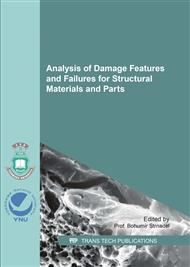p.31
p.36
p.42
p.50
p.57
p.63
p.70
p.76
p.82
Analysis on Critical CTOD of Long-Term Used Penstock
Abstract:
Many studies have been conducted to characterize the fracture toughness of structural steels and their welded joints. However, most studies focus on newly developed steels, and the number of studies on the fracture toughness of long-term used steels in structural components is rather limited. Furthermore, a lack of data on the fracture toughness causes difficulties in evaluating the structural integrity of existing steel structures. In this study, CTOD tests were performed to characterize the fracture toughness of penstock that has been in service for 50 years. By measuring the critical crack tip opening displacement in conjunction with analysis for chemical compositions, the characteristics of fracture toughness were investigated.
Info:
Periodical:
Pages:
57-62
Citation:
Online since:
June 2017
Authors:
Price:
Сopyright:
© 2017 Trans Tech Publications Ltd. All Rights Reserved
Share:
Citation:


